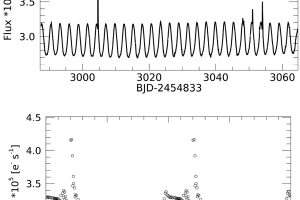An Hot Jupiter that may not be there. The study: “The GAPS Programme at TNG. XXVII. Reassessment of a young planetary system with HARPS-N: is the hot Jupiter V830 Tau b really there?” of M. Damasso (INAF-OATo) recently appeared on A&A

Some of the exoplanets known so far belong to classes that do not exist in our Solar System. For instance, the class of the Hot Jupiters, i.e., gaseous giant planets orbiting at close distances from their stars (typically less than 0.5 AU, Astronomical Unit, where a 1 AU is the average distance between Sun and Earth, about 150 million km). It is not clear to date what is the main mechanism responsible for the formation of Hot Jupiters. The leading hypothesis is the “planetary migration”: planets form at large distances from their stars, but then they migrate at close orbits. In newborn systems, this migration is due to the interaction between the young planets and the disk of gas and dust where planets formed, the so-called “protoplanetary disks”.
Protoplanetary disks disperse in a few million of years. For this reason, it is important to identify planets orbiting pre-main sequence stars in order to discriminate between planet-disk interaction and other suggested mechanisms that may lead to planet migration. However, to date only a few planets orbiting such young stars are known: for instance, the Hot Jupiters around the stars V830 Tau (2 million years) and TAP 26 (17 million years), and the four exoplanets orbiting around the star V1298 Tau (20 million years), all the in Taurus star forming region; the Hot Jupiter orbiting around the 1.2 solar masses star HIP 67522 in the Scorpius-Centaurus OB association (10-20 million years), or the super-Neptune orbiting around the star K2-33 in the Upper-Scorpius association, 11 million years old. One of the main difficulty in identifying stars around such young stars with the method of the radial velocity (which consists in detecting the oscillations of the stars induced by the orbit of their planets through high-resolution spectroscopy) is their intense magnetic activity. Magnetic phenomena such as chromospheric activity or photospheric spots, can in fact produce radial velocity signals that can mimic or contaminate the signal due to planets.
Given the importance of the few Hot Jupiters known orbiting around very young stars, V830 Tau has been observed with the spectrographs HARPS-N mounted on the Telescopio Nazionale Galileo, in the framework of the program GAPS (Global Architecture of Planetary Systems), in order to confirm the presence of the planet and characterize it thanks also to the light curve (e.g. the time variation of the stellar luminosity in a given band) obtained with the Kepler telescope. HARPS-N observations cover a time frame of 2.5 years. The team of researchers led by the astronomer M. Damasso (INAF – Astrophysical Observatory of Turin) analyzed this long serie of observations by adopting three different methods and then combining the results, with the aim of isolating the radial velocity signal due to the planet from the contamination due to the stellar activity. Despite this complicated procedure, the team could not isolate the signal due to the planet, and thus it was not possible to confirm its presence. Obviously, this doe not necessarily mean that the planet does not exist, also because the magnetic activity of V830 Tau is strongly variable. New observations are thus required in order to confirm the presence of this planet. The study is described in the paper: “The GAPS Programme at TNG. XXVII. Reassessment of a young planetary system with HARPS-N: is the hot Jupiter V830 Tau b really there?“, recently appeared on Astronomy & Astrophysics. The astronomers S. Benatti, L. Affer, A. Maggio, J. Maldonado e G. Micela of INAF – Astronomical Observatory of Palermo are coauthors of this work.
The figure (click here to visualize the entire image) shows the Kepler light curve of V830 Tau. The top panel shows the whole light curve. The modulation due to the rapid stellar rotation (with a period of 2.74 days) is evident. The sudden increases of brightness are stellar flares. The bottom shows the phase-folded light curve.
Mario Giuseppe Guarcello ( follow mguarce)
